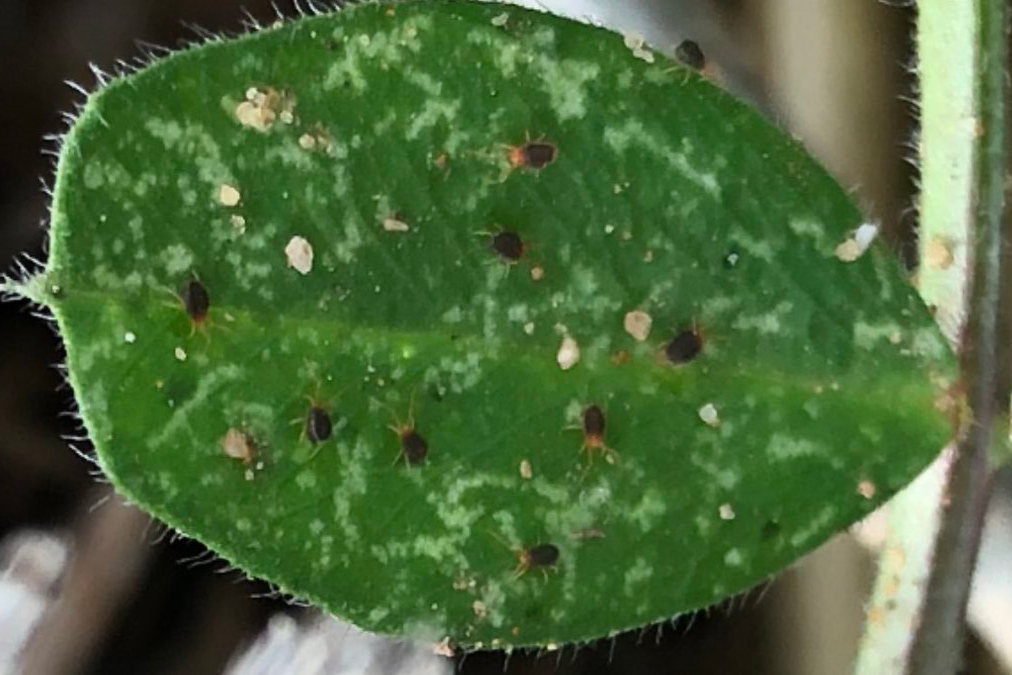Mites are ‘suckers’.
They aren’t ‘chewers’ like lucerne flea, beetles, earwigs, crickets and moth larvae.
They won’t tear away and consume chunks of foliage or lop leaves and stems.
Rather, feeding by mites creates silver-white patches or trails on leaves, the result of tissue damage as they pierce or scrap the leaf surface to suck out the nutritious cell contents.
Under heavy infestations, this type of feeding can distort plants, causing leaves to shrivel, wilt or ‘cup’, and can cause significant crop losses at establishment.
A season of all mite sorts
We previously reported on mites challenging a number of establishing crops this season.
There have been further reports of Bryobia mite (Bryobia spp.) damage this winter. In the NSW Riverina, Bryobia mites have decimated large patches of a canola crop. Further north-east in the NSW South West Slopes, growers have had widespread issues with Bryobia this season.
Blue oat mites (Penthaleus spp., BOM) have also been reported in a number of crops and pastures during June. In Victoria’s Northern Country, a very high infestation has been reported damaging an oat crop. Further north-west in the Victorian Mallee, BOM was reported in lentils, vetch, and barley in early winter.
Our correspondence through Pest Facts south-eastern has highlighted that some growers and advisers have been trying to avoid use of broadspectrum actives for mite control where possible, and we have noted reports from the field where there has been little need to spray for mites across multiple years. This is encouraging to hear from a both insecticide resistance management, and integrated pest management perspectives! When spraying is not avoidable, it is crucial to understand exactly what mite you are attempting to manage.
How to use damage to aid identification
While identification should largely focus on the critters themselves, the small size of mites can make this difficult (although not impossible) infield, and you may wish to scutinise the damage itself for further clues, while remaining aware of its limitations.
Patches
In broadleaf plants, redlegged earth mite (RLEM, Halotydeus destructor) and BOM damage manifests in large solid-like patches of silvering.
But this is feature not always obvious or consistent on cereals and grasses, on which their damage can appear more ‘stippled’ or disjointed and may overlap with symptoms caused by Bryobia mite or brown wheat mite (Petrobia latens).

Photo by Cesar Australia 
Photo by Phil Bowden
Trails and stippling
When Bryobia mites feed, they often create distinctive trails of silver-white dots, which can give foliage a stippled appearance. This symptom is mostly evident on broadleaf plants; on cereals their damage could be confused with that of RLEM or BOM. Furthermore, under heavy infestations on broadleaf plants, feeding may be so extensive that the stippling eventually looks like a large patch, and the trails are not so obvious.
Brown wheat mite feeding in cereals also often creates stippling. Under severe brown wheat mite infestations, cereals often take on a drought-stressed appearance.

Photo by Matt Witney 
Photo by Matt Witney

Photo by Cesar Australia 
Photo by Daniel Andrews
More information
Are you after more information on mites including management advice?
We have a huge repository of pest information known as PestNotes.
They are comprehensive factsheets on key pests of broadacre crops and pastures, including redlegged earth mite, blue oat mites, Bryobia mite and Balaustium mite.
Cover image: Photo by Cesar Australia





